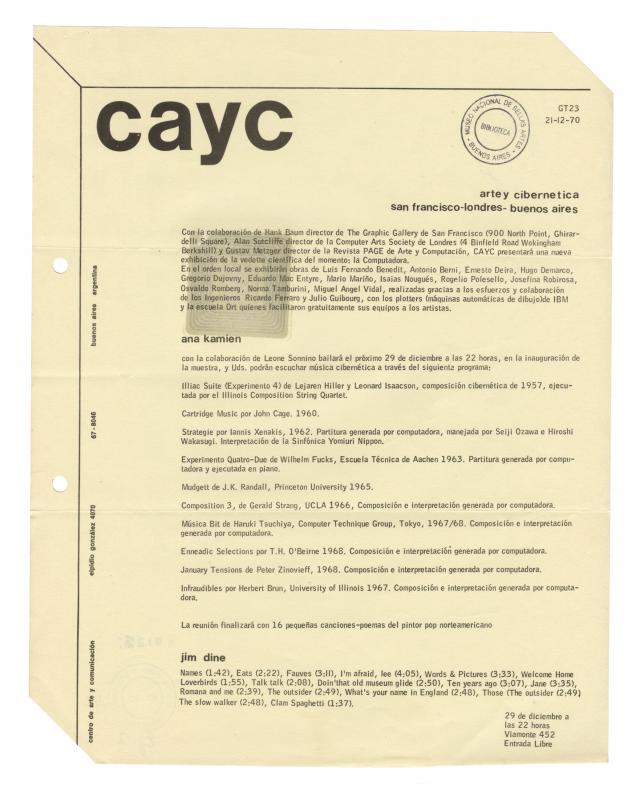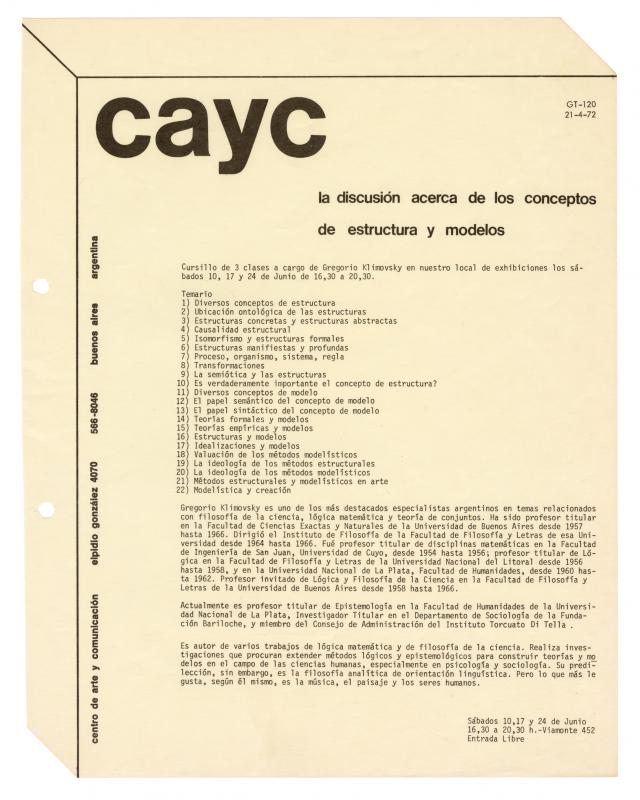Ever since it was founded, the CAYC (Centro de Arte y Comunicación), helmed by the cultural promoter, artist, and businessman Jorge Glusberg, was intended as an interdisciplinary space where an experimental art movement could flourish. The establishment of collaborative networks connecting local and international artists and critics played an important role in this process. In addition to the exhibitions, a program of different activities exposed attendees to the latest in art and scientific thinking. According to Glusberg, the coordination between theoretical thinking and artistic practice was an essential part of social change.
During the military dictatorship of General Juan Carlos Onganía, the CAYC became a cultural home for the Fundación de Investigación, a space that welcomed a group of dissident professors from the Facultad de Arquitectura y Ciencias Exactas de la Universidad de Buenos Aires after the military takeover of the university in what came to be known as “La Noche de los Bastones Largos” in June 1966. In its early years the center organized a variety of activities with intellectuals that contributed to the circulation of ideas from different disciplines (analytical philosophy, mathematical logic, epistemological problems, psychology, semiotics, and linguistics), which had been excluded from official circles.
The center’s interest led to the creation of the Escuela de Altos Estudios (EAE) in January 1973 (GT- 201; doc. no. doc. no. 1478752). Though gatherings of this kind had happened before—some of them were associated with the Sociedad Argentina de Análisis Filosófico (SADAF)—the EAE created a formal space that included academics and intellectuals where ideas could be shared.
This newsletter invites readers to attend a new seminar to be presented by Gregorio Klimovsky (1922–2009), at which he will discuss the possibilities that the philosophy of science might offer creative activity, in this case based on “the concept of a model.”
In 1969 Klimovsky—and a group of engineers, analysts, and programmers directed by Ricardo Ferraro and Julio Guibourg—took part in the center’s first exhibition, Arte y Cibernética (GT-23; doc. no . 1476279). This exhibition established the CAYC’s experimental credentials, which were in line with ideas that had already been presented on the international stage that aimed, among other things, to communicate the potential of working with new technologies for creative purposes and the need to adopt an interdisciplinary approach that would “reflect the period in which we live.” Klimovsky had also taken part in other training activities (GT-45; doc. no. 1478592, GT-120; doc. no. 1478802, GT-191; doc. no. 1478748) prior to the establishment of the EAE.
The center used these interdisciplinary events to explore the possibilities that recent linguistic theories might offer for artistic activity, particularly those that would support the CAYC’s program of activities and the creation of an institutional poetics of its own that would establish its identity in Latin America.


